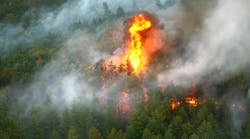This supplement on the role of herbicides in vegetation management programs has been a long time coming. Several years ago, Rick Bush, editorial director of Transmission & Distribution World, and I were walking the show floor at the annual meeting of the International Society of Arboriculture and talking with utility arborists, technical consultants, herbicide manufactures and vegetation management companies. We came away convinced that an individual article here or there would not do the vegetation management community or our electric utilities justice. We needed a single supplement that could cover all aspects of herbicide use while providing an understanding of where herbicides would fit in the overall vegetation management toolbox. But supplements require persistence and hard work in locating and selecting articles while building the interest of the advertising community. Here we are in 2012, and this supplement has finally come together.
We are proud of the impact this supplement will have on the future of herbicides in arboriculture. The authors in this supplement are members of the Utility Arborist Association (UAA) and renowned in their own right. I encourage you to take a long read, then share this supplement with your utility coworkers. As a past president of the UAA and former vegetation program manager at Pacific Gas & Electric, I have been involved personally in expanding the use of herbicides to address clearance and rights-of-way (ROW) issues while improving wildlife habitat and tackling the scourge of invasive species.
So if you and your utility still think of vegetation management as only tree trimming and mowing, we would like to open your eyes to the concept of integrated vegetation management (IVM) strategies. IVM is not an action, rather, it is a program that requires executive oversight and professional execution.
A comprehensive IVM program is a proactive approach to dealing with ROW issues and puts you in front of potential issues with your customers. If you work at a utility that has put off comprehensive management of its ROW, you might have to do some remedial work or reclamation. Reclamation (as defined in ANSI A300 Part 7) would require you to address tall, dense amounts of undesirable vegetation. Reclamation usually involves initial nonselective methods of mowing or hand-cutting, or broadcast application of herbicides.
But once you have the ROW back to some semblance of order, what do you do next? How do you maintain what you now have? Here is what ANSI says: “The reason for IVM is to promote sustainable plant communities that are compatible with the intended use of the site and discourage incompatible plants that may pose concerns, including safety, security, access, fire hazard, electric service reliability, emergency restoration, visibility, line-of-sight requirements, regulatory compliance, environmental or other specific concerns.”
So we could look at enhancement as coming into the maintenance phase of a vegetation management program. Using an enhancement strategy requires close partnering with the landowners and with the community while avoiding or reducing the likelihood of media disasters and possible reactive governmental regulation.
Failure to Plan Is a Recipe for Disaster
When you look into many of the media stories on ROW reclamation, they usually involve a radical removal program that was not well thought out or planned. Typically, these projects are poorly communicated to both internal and external stakeholders. Some utilities have adopted the clear-cut approach to meet the recent NERC requirements. When one of these projects results in a media storm or a public outcry, the utility is often surprised. Yet the result of a poor approach is all too predictable. The term “clear cut” is a favorite term used by upset landowners and the media. Let's make sure we are taking appropriate and strategic actions.
No less a force than FERC Chairman Jon Wellinghoff says, “Successful vegetation management programs help property owners maintain and even enhance the environmental benefits and aesthetics of the right-of-way while ensuring sufficient clearance between the vegetation and energized conductors.
“In my view, the most successful vegetation management programs have, as one of the core elements, a strategy to engage the property owners in an adequate, timely and forthright manner and to work cooperatively with those property owners.”
Utilities Take the Lead
Several of our utilities are demonstrating the use of comprehensive IVM to address seemingly intractable community issues. Recently, Sacramento Municipal Utility District (SMUD), Western Area Power Administration and Pacific Gas & Electric planned an enhancement project with the Pollinator Partnership and Sacramento Parks Department.
The leadership on this enhancement effort was coordinated by Steve Hallmark at SMUD, who recently hosted a meeting with all internal and external partners. Internal partners from environmental policy and media and external partners from the Sacramento Parks Department and the Pollinator Partnership were there to support the enhancement opportunity.
Dow and DuPont offered assistance in developing several herbicide applications to reduce noxious weeds, protect pollinator species and enhance native grasses. The applications are planned to include the control of undesirable tall brush and tree species while encouraging low-growing brush species that will provide valuable pollinator habitat. This location is also a demonstration of how to enhance the cavity nesting habitat on several ROW corridors using hack and squirt herbicide applications to kill fast-growing tree species and create snags for cavity nesting species.
Utilities can enhance ROW for recreational uses. A NERC critical ROW in Northern California was successfully reclaimed in a popular cross-country ski and mountain biking area, with the utility working to enhance these activities while clearing all incompatible trees within the ROW. Another example of using an enhancement strategy for success was on Sierra National Forest in California. The vegetation manager was able to enhance the ROW for wildlife and culturally significant resources while protecting rare botanical resources. The Forest Service biologist suggested leaving brush piles for enhanced wildlife cover, and the concept was incorporated into the utility's reclamation plan. We all know how difficult federal agencies can be for utilities, and this is an excellent example of how an enhancement strategy can build support from the agencies.
Enhancement is a natural fit with Integrated Vegetation Management Best Management Practices, as provided in ANSI A300 Part 7. From communication to planning and implementation, an enhancement strategy will help a utility hit or exceed reliability and safety targets while developing and improving its community and corporate image.
During the planning stages, it is important to make contact with internal and external stakeholders to explain the utility's objectives and to discuss the goals and concerns of the landowner.
Enhancement strategies often build support from state and federal wildlife agencies and conservation groups. And when dealing with the U.S. Forest Service and Bureau of Land Management, look for opportunities to enhance wildlife, fuels management and support plant diversity. Success with one government agency can be used as an example to expedite ROW projects on other federal and state lands.
When working with landowners, work toward a long-term sustainable vegetation type. IVM planning site evaluations rarely will require the removal of all vegetation in only one cycle. Midspan and category 2 trees along the edge of the ROW are generally the real risk to NERC compliance and should be addressed quickly.
Reasonable actions should take in thresholds that will keep the line safe and reliable, and should take into account vegetation growth, line sag and line sway. When tackling large removal projects, understand it is not necessary or desirable to remove all trees, regardless of size or location. Clear-cut approaches too often result in a utility forced to modify action thresholds after significant damage has been done to a utility's corporate image.
We at the UAA would like to be a resource for you. We encourage senior leadership at our electric utilities (executives in media, environmental and governmental relations) to ask tough questions of their vegetation management departments. Be sure to look at the true costs and impacts of an IVM solution. An enhancement strategy allows utilities to have more successful, cost-effective vegetation management solutions. It is hard work to develop sound long-term vegetation management solutions leading to good relations with our customers, stakeholders and regulators.
Nelsen Money, president of NRM-VMS Inc. and a past president of the Utility Arborist Association, has more than 38 years of utility vegetation management experience. He is an ISA certified arborist/utility specialist, California licensed professional forester and California licensed pest control advisor.

